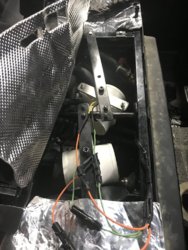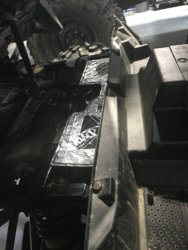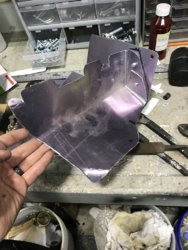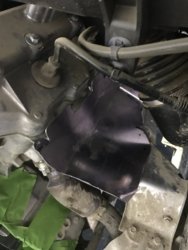You are using an out of date browser. It may not display this or other websites correctly.
You should upgrade or use an alternative browser.
You should upgrade or use an alternative browser.
Delton
Honda Fanboy
Vendor
Lifetime Member
Club Contributor
I've got 50ft of it but haven't installed it yet. Headpipes like to sweat and this stuff traps any moisture which leads to premature rust. I'd recommend removing it periodically or maybe even ceramic coating the header, but that's pretty expensive. I've used it several times on turbo applications. Makes considerable power difference.has anyone wrapped the headers with this stuff? I was wondering how good it works. Its 20 bucks on amazon and 60 at autozone! same stuff
Amazon.com: LEDAUT 2" x 50' Titanium Exhaust Heat Wrap Roll for Motorcycle Fiberglass Heat Shield Tape with Stainless Ties: Automotive
J
JTW
Guest
You feel like it's enough?I did one
Sent from my iPhone using Tapatalk
Delton
Honda Fanboy
Vendor
Lifetime Member
Club Contributor
I've got 2 3" blowers and Joey has 1 4". I brought my temp gun along on a ride and he had lower seat temp than I did.You feel like it's enough?
This is an exert from an online Hot Rod magazine reguarding coatings. The headers on my Dart are coated inside and out.
As a part of our test, we wanted to quantify the benefits of a coated header versus a plain uncoated black painted header. A thermal barrier ceramic coating adds considerably to the price of any header, often doubling the price. We tested two otherwise identical Hooker 1⅞-inch headers with surprising results. Running on the dyno, we found the power numbers virtually unchanged (see Average Power table on next page). Where the ceramic coating made a remarkable difference is in the heat transferred by the header. We tested the header temperature immediately after a run, and then one minute after shutdown. The coated headers measured 258 degrees F dropping to 195 degrees F a minute after shutdown. In contrast, the uncoated header measured a scalding 870 degrees, retaining 520 degrees a minute after shutdown. We didn’t need a heat gun to tell the difference in the test cell.
Our next test loaded the engine to 60 lb-ft of torque at 2,800 rpm, simulating a high-speed cruise situation. We gauged the surface temp of the header once fully stabilized. Once again, the difference was huge, with the coated header showing 288 degrees, while the uncoated header recorded 850 degrees. While the dyno run didn’t show much difference in output, an engine breathing air from under the hood will definitely feel the effects of that extra 562 degrees F pumping into the engine bay. Taking account the effects of heat on engine component life and passenger comfort, the coated headers are definitely a winner.
As a part of our test, we wanted to quantify the benefits of a coated header versus a plain uncoated black painted header. A thermal barrier ceramic coating adds considerably to the price of any header, often doubling the price. We tested two otherwise identical Hooker 1⅞-inch headers with surprising results. Running on the dyno, we found the power numbers virtually unchanged (see Average Power table on next page). Where the ceramic coating made a remarkable difference is in the heat transferred by the header. We tested the header temperature immediately after a run, and then one minute after shutdown. The coated headers measured 258 degrees F dropping to 195 degrees F a minute after shutdown. In contrast, the uncoated header measured a scalding 870 degrees, retaining 520 degrees a minute after shutdown. We didn’t need a heat gun to tell the difference in the test cell.
Our next test loaded the engine to 60 lb-ft of torque at 2,800 rpm, simulating a high-speed cruise situation. We gauged the surface temp of the header once fully stabilized. Once again, the difference was huge, with the coated header showing 288 degrees, while the uncoated header recorded 850 degrees. While the dyno run didn’t show much difference in output, an engine breathing air from under the hood will definitely feel the effects of that extra 562 degrees F pumping into the engine bay. Taking account the effects of heat on engine component life and passenger comfort, the coated headers are definitely a winner.
This is another modification I need to do, as of yet I have done nothing to deal with the heat issue. Insulation and a bilge fan will both be installed before this summer.
GlockMeister
The Bearded Wonder
Lifetime Member
Supporting Member
I have one 4 inch blower..But will be adding another to the driver's side as I still get some heat there. But one is substantially better than none.You feel like it's enough?
J
JTW
Guest
I'll leave a little extra wire to be on the safe side.I have one 4 inch blower..But will be adding another to the driver's side as I still get some heat there. But one is substantially better than none.
advertisement
GlockMeister
The Bearded Wonder
Lifetime Member
Supporting Member
Driving slow speed is where the blower seems to help the most. The passenger side and middle is quite a bit cooler on mine with just the one blower. I think two would almost completely eliminate the heat issue.I'll leave a little extra wire to be on the safe side.
I have added an extra heat shield, used heat blocking material under seat and two blowers, and wrapped exhaust with titanium header wrap don't get any heat. I also fashioned a large piece of sheet metal coated with sound blocker that covers under the back seat and around the motor (hard to explain). Don't have any problem with heat and sound is a bit better (have IGR so it's a little louder).
the shield works good for me. water in the engine compartment does steam the back of the seat. but I do not go thur any thing deeper than a couple inches. Need a snorkel on it to go deeper than that. look at some of the post about water in the motor!!!
w
thanks
how about a pix of the sheet metal piece would like to make one looking for ideals.I have added an extra heat shield, used heat blocking material under seat and two blowers, and wrapped exhaust with titanium header wrap don't get any heat. I also fashioned a large piece of sheet metal coated with sound blocker that covers under the back seat and around the motor (hard to explain). Don't have any problem with heat and sound is a bit better (have IGR so it's a little louder).
thanks
Here is a few pics I wired the blowers with weather pak single connectors so I can just reverse them when its cold, If you can kinda make out the other pic its with the bed up and that metal piece runs along frame and around the engine. The bottom of the floor is also covered in the dynamat material as well.








J
JTW
Guest
How much quieter is it with the dynamat?Here is a few pics I wired the blowers with weather pak single connectors so I can just reverse them when its cold, If you can kinda make out the other pic its with the bed up and that metal piece runs along frame and around the engine. The bottom of the floor is also covered in the dynamat material as well.
View attachment 31854 View attachment 31855 View attachment 31856 View attachment 31857
J
JTW
Guest
Sweet.. I bought some for that and the top of my skid platesFrom 86 to 87db at front seats lowered to 78db at front seats after all said and done which is a significant difference.
advertisement
Similar threads
- Replies
- 16
- Views
- 3K
B
- Replies
- 37
- Views
- 5K
- Replies
- 11
- Views
- 2K



